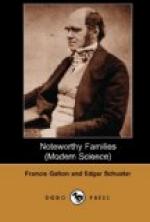___________|
Those relationships that are expressed by different combinations of these letters differ specifically; therefore, in saying, in the next chapter, that each person has “roughly, on the average, one fertile relative in each and every form of specific kinship,” it means in each and every combination of the above syllables that is practically possible.
Relationship may also be expressed conveniently for some purposes in Degrees of remoteness, the number of the Degree being that of the number of syllables used to express the specific kinship.
CHAPTER VII.—NUMBER OF KINSFOLK IN EACH DEGREE.
The population may be likened to counters spread upon a table, each corresponding to a different individual. The counters are linked together by bands of various widths, down to mere threads, the widths being proportional to the closeness of the several kinships. Those in the first degree (father, mother, brother, sister, son, daughter) are comparatively broad; those in the second degree (grandparent, uncle, aunt, nephew, niece, grandchild) are considerably narrower; those in the third degree are very narrow indeed. Proceeding outwards, the connections soon become thinner than gossamer. The person represented by any one of these counters may be taken as the subject of a pedigree, and all the counters connected with it may be noted up to any specified width of band. In this book one of the counters is supposed to represent a Fellow of the Royal Society, whose name appears in the “Year-Book” of that Society for 1904, and the linkage proceeds outwards from him to the third degree inclusive. Usually it stops there, but a few distant kinships have been occasionally inserted chiefly to testify to a prolonged heritage of family traits.




